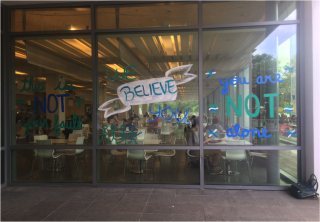Protecting the One in Five: A Call to Action on Campus Sexual Assault
June 8, 2015
By Courtney Liss
Media coverage of Emma Sulkowicz’s performance art is drawing attention to a very serious and widespread issue: today, one out of every five women on a college campus has been sexually assaulted. President Obama himself spoke about it just last year. Worse, it is estimated that only 12 percent of sexual assaults are reported, meaning that far more college women have been forced to endure sexual assault while pursuing higher education than the official statistics suggest. Women do not and cannot have safe and equal access to education while facing this kind of threat—an injustice compounded by the fact that many schools discourage victims from coming forward, fail to disclose the scope of the problem on their campuses, and leave students to discuss their assaults with untrained employees.
By giving colleges and universities complete freedom in dealing with sexual assault cases, we allow them to make decisions in their own interests at the cost of the safety of their students. Often, this means discouraging victims from coming forward in order to lower the official count of sexual assaults on their campus (which have to be reported annually due to the Jeanne Clery Act). We need federal action to ensure that colleges and universities treat victims properly, report accurate statistics to the federal government and guarantee that on a local, campus level, women are able to pursue a quality education without fear of sexual assault.
After hearing from women on my campus, I realized that the issue of sexual assault goes beyond its frequency. Instead, a combination of factors—negative administrative responses to reporting, retaliation against victims from social groups, and the incessant questioning of victims (What were they wearing? Were they drunk?)—have coalesced into a far broader problem. In our current system, women are often left wondering whether it is worth the effort to go through their school’s disciplinary process at all. I knew I needed to do something about this—both on my campus and nationally. The one in five women on your campus need you, too.

How can you address sexual assault on your campus? The first priority has to be making survivors feel safe. On my campus at Tulane University, I painted the windows of our student center with survivor-friendly messaging: “You are not alone,” “We believe you,” and “This is not your fault.” Not only does this help demonstrate appropriate responses to sexual assault incidents, it also expresses support to survivors on campus. By painting the windows of your campus, you can display your #clearsupport for sexual assault victims.
But painting on windows alone will not create the lasting change we need to end campus sexual assault. We need federal and state-sponsored policy legislation. Along with other advocates on my campus, I tabled directly outside the painted windows to get student signatures on letters supporting the Bipartisan Campus Accountability and Safety Act, a U.S. Senate bill that would establish confidential advisors at universities, ensure training of on-campus security officials, force colleges to report sexual assaults by raising Title IX and Clery Act reporting fines, and have colleges utilize “one uniform process for campus disciplinary proceedings.” I encourage you to look up the Campus Accountability and Safety Act, or a piece of local or state legislation that addresses this issue, and work to gather support on your campus as well.
One in five is an unacceptably high number of women who have already been sexually assaulted. To protect college women from becoming a victim, we as college students need to speak up and out and demand that colleges make the changes we need now.